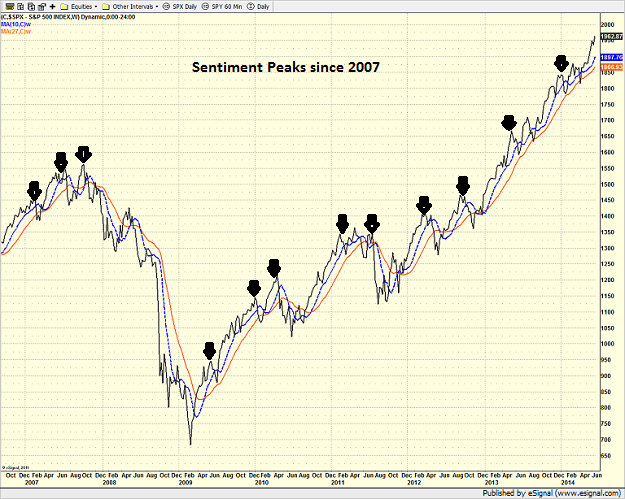To be sure, correctly analyzing investor sentiment and then acting accordingly in one's portfolio can be challenging over the long-term. Everybody knows to be wary of the crowd when everyone is expecting the same thing to happen in a given market. Yet at the same time, everyone can't be a contrarian, right?
The outlook for the current market is a perfect example of the sentiment dilemma. In short, most of the market sentiment indicators suggest that there is a great deal of optimism in the market at the present time. However, it is important to note that this may be one of the most hated market moves in history.
There aren't many pound-the-table bullish investment managers at this time. No, just about every manager seems nervous to some degree right now. However, the market models designed to indicate degrees of optimism/pessimism tell a different story.
A Sentiment Indicator Worth Watching
For example, Ned Davis, proprietor of Ned Davis Research, has made a career out of analyzing investor sentiment. NDR has several investor sentiment models, one of which has been live for nearly 20 years. As such, when this indicator "talks" it is a good idea to "listen." The bottom line is that Ned's indicator says sentiment is either at, or very close to an extreme optimism reading.
Related Link: 2014: The Little Crisis That Couldn't
This particular sentiment indicator looks at the data from Investors Intelligence, American Association of Individual Investors, CBOT Put/Call Ratios, Rydex Funds asset levels and MBH Commodity Advisors, as well as other indicators.
The trick to using the model successfully is to watch for an extreme level to be reached (in either direction) and then wait for the level of optimism/pessimism to reverse. This suggests that sentiment has become overdone and it is likely time for the market to go the other way. History shows that heeding such an event has been quite profitable.
Below is a chart of the S&P 500, plotted weekly, with arrows placed at the peaks seen in NDR's sentiment indicator.
S&P 500 - Weekly

When reviewing the chart, it should be clear that extreme sentiment readings tend to lead to declines in the stock market. Sometimes the ensuing declines are modest. But then there have been times when the drops are quite meaningful.
For example, since the beginning of 2007, there have been 12 peaks in this indicator's optimism readings. Measuring the total S&P points between the peak in optimism and the ensuing extreme pessimism reading reveals that the S&P has lost a cumulative 1,830 points.
Related Link: What History Tells Us About Markets And Middle East Crises
Another way to look at this is the S&P has lost an average of 166 points after each extreme reading in optimism.
Going back to 1995, there have been 41 extreme optimism readings. Doing the math reveals that the S&P has lost a total of 10,500 points after the extreme readings. This means that on average, the S&P has lost an average of 256 points after the peaks in optimism have been reached.
What's more, over the last 19 years, the market has never gained ground after an extreme optimistic reading has been reached until the next extreme pessimism reading.
The Big Point
Sure, there are some big losses - 2008 for example - that clearly impact the mean loss for this indicator. However, the key point is that peaks in optimism have simply not been good spots to buy!
What Is The Indicator Saying Now?
As of last week, this sentiment indicator is not at an extreme level for the current cycle. However, the current reading is either higher than, or very close to the peaks seen in May 2013, September 2012, March 2012, July 2011, April 2010, January 2010, June 2009 and May 2007.
To be clear, the indicator is NOT flashing a sell signal at this point. However, it is worth noting that the sentiment indicators suggest that optimism is quite high - and could easily reverse should the bears find a raison d'être.
Therefore, it is probably a good idea to recognize that risk is elevated at this time and that one should play the game accordingly. In other words, this is no time to be complacent.
Click Here to Receive the full "Daily State of the Markets" report each morning before the opening bell. Dave's full report includes a list of the current market drivers, trend analysis, key technical levels, six momentum indicators, two early warning indicators, the weekly State of the Market Model, pre-open analysis, and a thought for the day.
Edge Rankings
Price Trend
© 2025 Benzinga.com. Benzinga does not provide investment advice. All rights reserved.
Trade confidently with insights and alerts from analyst ratings, free reports and breaking news that affects the stocks you care about.